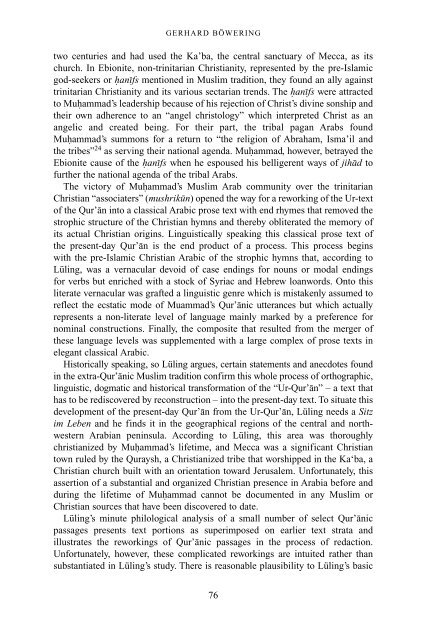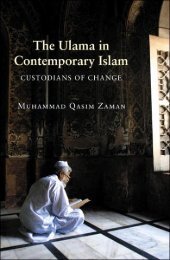The Qur'an in its historical context (pdf - Islam and Christian-Muslim ...
The Qur'an in its historical context (pdf - Islam and Christian-Muslim ...
The Qur'an in its historical context (pdf - Islam and Christian-Muslim ...
You also want an ePaper? Increase the reach of your titles
YUMPU automatically turns print PDFs into web optimized ePapers that Google loves.
GERHARD BÖWERING<br />
two centuries <strong>and</strong> had used the Ka’ba, the central sanctuary of Mecca, as <strong>its</strong><br />
church. In Ebionite, non-tr<strong>in</strong>itarian <strong>Christian</strong>ity, represented by the pre-<strong>Islam</strong>ic<br />
god-seekers or hanifs mentioned <strong>in</strong> <strong>Muslim</strong> tradition, they found an ally aga<strong>in</strong>st<br />
tr<strong>in</strong>itarian <strong>Christian</strong>ity <strong>and</strong> <strong>its</strong> various sectarian trends. <strong>The</strong> hanifs were attracted<br />
to Muhammad’s leadership because of his rejection of Christ’s div<strong>in</strong>e sonship <strong>and</strong><br />
their own adherence to an “angel christology” which <strong>in</strong>terpreted Christ as an<br />
angelic <strong>and</strong> created be<strong>in</strong>g. For their part, the tribal pagan Arabs found<br />
Muhammad’s summons for a return to “the religion of Abraham, Isma’il <strong>and</strong><br />
the tribes” 24 as serv<strong>in</strong>g their national agenda. Muhammad, however, betrayed the<br />
Ebionite cause of the hanifs when he espoused his belligerent ways of jihad to<br />
further the national agenda of the tribal Arabs.<br />
<strong>The</strong> victory of Muhammad’s <strong>Muslim</strong> Arab community over the tr<strong>in</strong>itarian<br />
<strong>Christian</strong> “associaters” (mushrikun) opened the way for a rework<strong>in</strong>g of the Ur-text<br />
of the Qur’an <strong>in</strong>to a classical Arabic prose text with end rhymes that removed the<br />
strophic structure of the <strong>Christian</strong> hymns <strong>and</strong> thereby obliterated the memory of<br />
<strong>its</strong> actual <strong>Christian</strong> orig<strong>in</strong>s. L<strong>in</strong>guistically speak<strong>in</strong>g this classical prose text of<br />
the present-day Qur’an is the end product of a process. This process beg<strong>in</strong>s<br />
with the pre-<strong>Islam</strong>ic <strong>Christian</strong> Arabic of the strophic hymns that, accord<strong>in</strong>g to<br />
Lül<strong>in</strong>g, was a vernacular devoid of case end<strong>in</strong>gs for nouns or modal end<strong>in</strong>gs<br />
for verbs but enriched with a stock of Syriac <strong>and</strong> Hebrew loanwords. Onto this<br />
literate vernacular was grafted a l<strong>in</strong>guistic genre which is mistakenly assumed to<br />
reflect the ecstatic mode of Muammad’s Qur’anic utterances but which actually<br />
represents a non-literate level of language ma<strong>in</strong>ly marked by a preference for<br />
nom<strong>in</strong>al constructions. F<strong>in</strong>ally, the composite that resulted from the merger of<br />
these language levels was supplemented with a large complex of prose texts <strong>in</strong><br />
elegant classical Arabic.<br />
Historically speak<strong>in</strong>g, so Lül<strong>in</strong>g argues, certa<strong>in</strong> statements <strong>and</strong> anecdotes found<br />
<strong>in</strong> the extra-Qur’anic <strong>Muslim</strong> tradition confirm this whole process of orthographic,<br />
l<strong>in</strong>guistic, dogmatic <strong>and</strong> <strong>historical</strong> transformation of the “Ur-Qur’an” – a text that<br />
has to be rediscovered by reconstruction – <strong>in</strong>to the present-day text. To situate this<br />
development of the present-day Qur’an from the Ur-Qur’an, Lül<strong>in</strong>g needs a Sitz<br />
im Leben <strong>and</strong> he f<strong>in</strong>ds it <strong>in</strong> the geographical regions of the central <strong>and</strong> northwestern<br />
Arabian pen<strong>in</strong>sula. Accord<strong>in</strong>g to Lül<strong>in</strong>g, this area was thoroughly<br />
christianized by Muhammad’s lifetime, <strong>and</strong> Mecca was a significant <strong>Christian</strong><br />
town ruled by the Quraysh, a <strong>Christian</strong>ized tribe that worshipped <strong>in</strong> the Ka‘ba, a<br />
<strong>Christian</strong> church built with an orientation toward Jerusalem. Unfortunately, this<br />
assertion of a substantial <strong>and</strong> organized <strong>Christian</strong> presence <strong>in</strong> Arabia before <strong>and</strong><br />
dur<strong>in</strong>g the lifetime of Muhammad cannot be documented <strong>in</strong> any <strong>Muslim</strong> or<br />
<strong>Christian</strong> sources that have been discovered to date.<br />
Lül<strong>in</strong>g’s m<strong>in</strong>ute philological analysis of a small number of select Qur’anic<br />
passages presents text portions as superimposed on earlier text strata <strong>and</strong><br />
illustrates the rework<strong>in</strong>gs of Qur’anic passages <strong>in</strong> the process of redaction.<br />
Unfortunately, however, these complicated rework<strong>in</strong>gs are <strong>in</strong>tuited rather than<br />
substantiated <strong>in</strong> Lül<strong>in</strong>g’s study. <strong>The</strong>re is reasonable plausibility to Lül<strong>in</strong>g’s basic<br />
76



